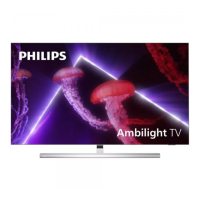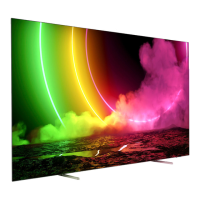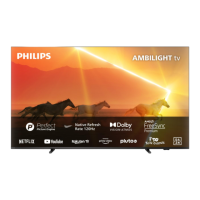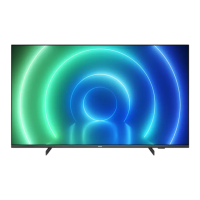
Do you have a question about the Philips 55OLED807 and is the answer not in the manual?
| Display Type | OLED |
|---|---|
| Screen Size | 55 inches |
| Operating System | Android TV |
| Ambilight | 3-sided |
| HDMI Ports | 4 |
| USB Ports | 3 |
| Sound Technology | Dolby Atmos |
| Refresh Rate | 120 Hz |
| Smart TV Platform | Android TV |
| Processor | P5 AI Perfect Picture Engine |
| Audio | 50W |
| Bluetooth | Yes |
| Resolution | 4K (3840 x 2160) |
| HDR | HDR10+, Dolby Vision |
| Wi-Fi | Yes |
| Voice Assistants | Google Assistant, Amazon Alexa |
| Dimensions (W x H x D) | 1227.8 x 705.6 x 68.0 mm (without stand) |
Explains the TV display refreshing process to protect the screen.
Provides guidelines to prevent image retention and screen damage.
Lists features like automatic refreshing, brightness control, and screen saver.
Explains how to navigate the Home screen and channels.
Details new features and navigation after a Home screen update.
Describes accessing and managing installed apps and collections.
Emphasizes reading safety instructions before TV use.
Covers instructions for TV stand and wall mounting.
Offers advice on optimal TV placement for viewing and Ambilight.
Details how to connect and manage the power cable for energy saving.
Details the functions of each key on the remote control.
Details how to switch the TV on, off, or to standby mode.
Explains basic TV operations using the physical joystick key.
Guides on installing channels, including antenna setup.
Explains how to view, search, and filter channel lists.
How to tune to channels using numbers or lists.
Explains how to lock and unlock channels using a PIN.
Setting age ratings to prevent access to unsuitable content.
Describes available options while watching a channel.
How to enable subtitles for digital and analogue broadcasts.
Manual subtitle adjustment for analogue channels.
Setting preferred primary and secondary subtitle languages.
Setting preferred primary and secondary audio languages.
Explains how to create and manage favourite channel lists.
Step-by-step guide to creating a new favourite channel list.
How to open, close, and navigate Teletext pages.
How to search for specific words within Teletext.
Accessing Teletext from connected external devices.
Information on Digital Text features available in the UK.
Various options for viewing and interacting with Teletext.
Setting preferred text language and Text 2.5 features.
Explains interactive TV services like HbbTV and MHEG.
Requirements for using interactive TV (digital channels, internet).
How to open, navigate, and control interactive TV pages.
Update Channels, Reinstall Channels, Reinstall TV.
Setting network frequency for channel scanning (Auto/Manual).
Manual entry of network frequency values.
Choosing between Quick Scan and Full Scan methods.
Adjusting step size for channel scanning (8MHz vs 1MHz).
Option to skip digital channel scanning.
Option to skip analogue channel scanning.
Overview of copying channel lists between TVs.
Requirements for copying channel lists (year, hardware, software).
How to check the current version of the channel list.
How to check the TV's current software version.
Steps to copy the channel list to a USB drive.
Instructions for uploading channel lists to a new or existing TV.
Connectivity Guide, Antenna port, HDMI ports.
Connecting an HTS to the TV using HDMI ARC/eARC.
Details on using HDMI ARC for audio.
Information on the enhanced Audio Return Channel.
Requirements for Bluetooth connectivity.
Steps to pair Bluetooth devices like speakers or headphones.
Minimum disk space requirements for pausing/recording TV.
Connecting and formatting a USB Hard Drive for PVR.
Home Network, Connect to Network (Wireless, Wired).
How to view current network configuration details.
Setting up a static IP address for network configuration.
Turning the TV's Wi-Fi connection on or off.
Clearing Philips server registration and app data.
How to sign in to Google for full Android TV capabilities.
Accessing premium apps available in the Smart TV Collection.
Agreeing to terms for using Smart TV Collection apps.
Configuring privacy settings for Smart TV Collection apps.
Overview of apps on the TV, sources, and installation.
Movies and TV, Games.
Locking apps for children, 18+ rated apps, or restricted profiles.
Setting maturity levels for app installation in Play Store.
Restricting TV usage to only allowed apps via a profile.
How to enter and exit the restricted profile.
Steps to delete the restricted profile.
How to launch and use the TV's internet browser.
Extra features available within the internet browser.
How to switch between connected devices and inputs.
Switching on connected devices and starting playback with one touch.
Setting specific options for connected TV inputs.
Assigning icons and names to connected devices.
Updating the Sources menu with newly connected devices.
Information on connecting the TV to a network.
Pairing a Device, Select a Device, Remove a Device.
Picture Settings, Al Picture Style, Customise a Style, Colour, Contrast, Sharpness, Black Level.
Adjusting noise reduction and MPEG artefact reduction.
Adjusting Ultra Resolution for sharper edges.
Fine-tuning colour, tint, and colour enhancement.
Adjusting light boost for power saving or better picture.
Enhancing details in dark, middle, and light picture areas.
Information on HDR formats and features like Perfect Natural Reality.
Improving contrast/brightness for HDR effects.
Setting HDR processing levels for optimal contrast.
Adjusting video contrast and gamma for picture luminance.
Selecting optimized motion settings for different content.
Reducing motion judder for smoother picture movement.
Sharpening picture movement and reducing motion blur.
Reducing eye strain in different ambient light conditions.
Enhancing dark details based on ambient light.
Optimizing colour temperature based on ambient light.
Selecting preset sound styles for different content types.
Restoring personalized sound settings to default.
Adjusting personal sound mode settings.
Speaker virtualizer, Clear dialogue, AI Equalizer, Custom AI Equalizer, TV Placement, DTS Play-Fi.
Adjusting volume and auto volume settings.
Balancing volume differences between TV and HDMI sources.
Selecting where TV sound is played (TV speakers or external system).
Setting eARC mode for enhanced audio transmission.
Configuring digital audio output formats for HDMI/Optical.
How to switch Ambilight on or off.
Selecting Ambilight styles like Follow Video, Lounge Light, Follow Audio.
Setting Ambilight to follow picture dynamics.
Setting Ambilight for ambient lighting in standby mode.
Setting Ambilight to follow country flag colors.
Using Ambilight with a control app.
Setting a custom static color for Ambilight.
Adjusting the brightness level of Ambilight.
Adjusting the saturation level of Ambilight colours.
Switching Ambilight on the bottom side on or off.
Adjusting brightness for Ambilight bottom side.
Adjusting Ambilight colours based on wall color.
Configuring Ambilight fade-out behavior on TV switch-off.
Tuning and locking warm white color variations for Ambilight.
Selecting halo effect types for Ambilight.
Turning off the TV screen to save energy.
Activating eye care feature for reduced eye strain.
Setting an automatic timer for the TV to switch off.
Adjusting settings for shop display or demo modes.
Selecting optimized or custom picture/audio for shop mode.
Turning the automatic demo mode on or off.
Refreshing the OLED screen to prevent image retention.
Turning automatic AI Picture demo mode on or off.
Adjusting HDMI Ultra HD signal quality (Standard, Optimal, Auto Game).
Automatically setting picture style based on film content detection.
Adjusting settings for HbbTV and operator apps.
Enabling HbbTV for interactive TV features.
Disabling tracking for HbbTV and operator apps.
Managing cookies for HbbTV and operator apps.
Clearing the list of user-approved applications.
Resetting the TV's unique device identifier.
Setting protection level for static images to prevent sticking.
Manually clearing image retention on the screen.
Changing TV menu and message languages.
Selecting preferred audio languages for digital broadcasts.
Selecting preferred subtitle languages for digital broadcasts.
Selecting preferred text languages for Teletext.
Setting the TV clock automatically or manually.
Adjusting time zone settings, available in certain countries.
Setting a sleep timer for automatic TV standby.
Enabling universal access for users with disabilities.
Accessing special audio and subtitles for hearing impaired users.
Using audio description for visually impaired users.
Increasing dialogue intelligibility for clearer sound.
Setting or changing the child lock PIN code.
Setting minimum age for watching rated programmes.
Locking specific apps or setting up restricted profiles.
Viewing media files from a computer or NAS over a home network.
Add to Favourites, View Favourites.
Viewing most popular and recently played media files.
Viewing media files from a connected USB drive or hard drive.
Accessing video folders on a USB device.
Playing individual video files and managing playback.
Various options for browsing and playing video files.
Open photo folder, View a photo.
Accessing 360 photo folders on a USB device.
Explains playback controls for 360 photos.
Accessing music folders on a USB device.
Playing individual music files and managing playback.
Options for browsing and playing music files.
Requirements for using the TV Guide (installed channels, data).
Information about TV Guide data availability and sources.
Open the TV Guide, Tune to a Programme, View programme details, Change Day, Set a Reminder, Search by Genre.
What You Need, Record Now, List of Recordings, Schedule a Recording.
How to pause and resume live TV broadcasts.
Replaying short segments of the currently watched broadcast.
Using the Philips TV Remote App for smartphone/tablet control.
What You Need, Apps with Google Cast, Cast to Your TV.
Requirements for playing games from Smart TV Collection or consoles.
Connecting wireless gamepads for playing games.
Connecting consoles/computers via HDMI to play games.
Integrated centre for game info display and settings control.
Follow Video, Follow Audio, Lounge Light, Follow Flag, Follow App, Custom Colour.
Steps to switch off the Ambilight feature.
General information on Ambilight settings.
Configuring Philips Hue bulbs to follow Ambilight colours.
Syncing Philips wireless speakers with Ambilight colours.
Explains how TV recommends programmes and services.
Agreeing to terms for personalized recommendations.
Recommends popular programmes currently on or starting soon.
Renting movies from an online video store.
Overview of Alexa voice control operations on the TV.
Using Alexa Skills for extended voice control capabilities.
Setup and usage instructions for Alexa on the TV.
Update from Internet, Update from USB, Look for OAD Updates.
How to view the current TV software version and details.
End of Use.
Electrical specifications including power, temperature, and saving features.
Specifies the TV's operating system version.
Details on aerial input, tuner bands, and video/audio playback formats.
Information on screen size and resolution.
Supported computer/video resolutions and refresh rates.
Lists connectivity ports on the side of the TV.
Lists connectivity ports on the bottom of the TV.
Benefits and steps for registering your TV for support.
How to access and use the on-screen help system.
TV Diagnose, Self-diagnose.
Troubleshooting issues with TV not switching on or remote control.
Troubleshooting problems with digital channels and lists.
Troubleshooting picture issues like distortion or no picture.
Addressing issues with poor antenna reception quality.
Troubleshooting picture issues from connected devices.
Resolving issues with picture settings changing unexpectedly.
Troubleshooting unexpected commercial banners.
Troubleshooting HDMI connection and device recognition issues.
Troubleshooting EasyLink functionality issues.
Explaining normal behavior when adjusting volume via HDMI-CEC.
Troubleshooting issues with USB media not displaying.
Addressing choppy playback due to USB transfer performance.
Troubleshooting Wi-Fi connection issues.
Troubleshooting internet connectivity problems.
Addressing slow internet and PC connection speeds.
Checking DHCP settings for connection issues.
Troubleshooting poor quality of streaming video playback.
Troubleshooting Bluetooth pairing issues.
Troubleshooting Bluetooth connection loss.
Addressing audio/video sync issues with Bluetooth devices.
Important Safety Information, Electric Shock or Fire Risks, Injury or TV Damage Risks, Stability Hazards, Battery Safety Risks.
General terms of use and warranty information for the TV.
Information on pixel characteristics and industry standards.
Information on backlight bleeding and uniformity.
Terms of use, privacy policy, and privacy settings for Smart TV.
Information on terms of use for the Smart TV Collection.
Trademark information for HDMI technology.
Patent information related to HEVC decoding technology.
Trademark information for NVIDIA G-SYNC technology.
Information about AMD FreeSync Premium technology.
Trademark information for Dolby Vision and Atmos technologies.
Information regarding IMAX Enhanced technology and patents.











